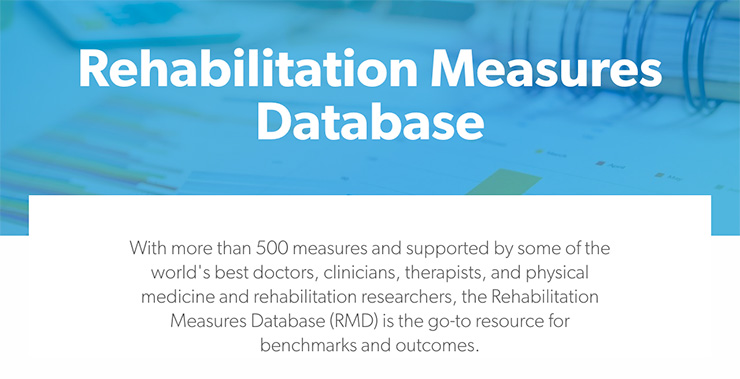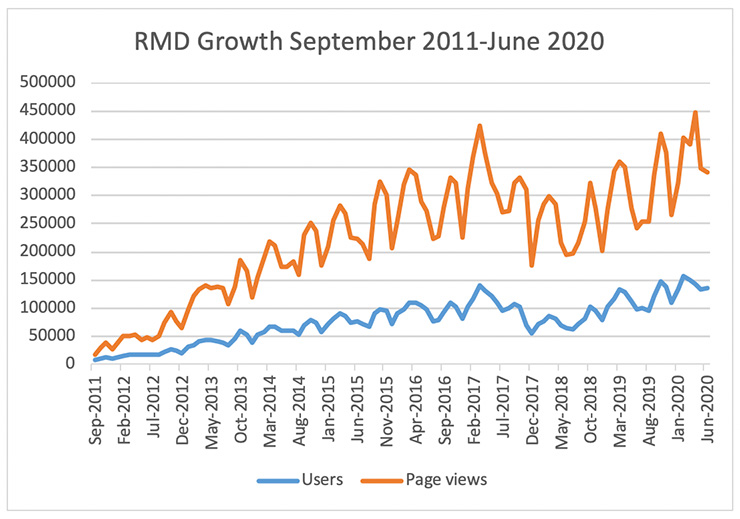(Updated) Rehabilitation Measures Database
Shirley Ryan AbilityLab
Submitted by Jennifer Moore and Jason Raad
Updated by Linda Ehrlich-Jones and Edeth Engel

Focus
Knowledge translation (KT) is promoted by using the most appropriate and sensitive data collection instruments. The Rehabilitation Measures Database (RMD) allows clinicians to use appropriate data collection tools to enhance the clinical translation of research evidence.
Context
A challenge that rehabilitation clinicians face is a lack of agreement of commonly used instruments for assessing patients and progress. Clinicians may not know which instruments have been validated or accurately tell apart symptoms and progress to specific clinical populations. The consistent use of valid and sensitive instruments allows clinicians to aggregate data and assess service effectiveness. This in turn leads to the development of evidence-based practices. Staff from the Rehabilitation Research and Training Center on Employment and Disability (RRTC) worked with rehabilitation clinicians to develop the RMD to address this challenge.
KT Activity
To solicit input on the creation of the RMD, the RRTC convened seven focus groups made up of 75 rehabilitation professionals. This input was the basis for the development of the RMD. This database is free, user-friendly, web-based, and searchable.
The RMD includes more than 500 measures. For each measure, the RMD provides a summary of the validity and reliability of the measure in different patient populations. The database also includes instructions for administering and scoring each instrument. In addition to the instrument summary, the RMD provides a link to download the instrument if it is freely available or information about where to obtain the instrument.
To be useful to rehabilitation clinicians, the resources within the RMD must be up to date. The RRTC works with clinicians, professional associations, and university faculty members to ensure that the information in the RMD is current. To that end, these collaborators help create summaries as new research becomes available and update existing summaries with new research. Health science programs use the RMD as part of their curricula. Students from these programs write instrument summaries for class credit. This helps keep the RMD current and ensures that participating students know how to use the database after they graduate and begin practice in their disciplines. Staff and volunteers at the Shirley Ryan AbilityLab go over data to make sure everything on the website is accurate and complete.
Impact
Between January 1, 2013, and August 31, 2013, the RMD averaged 1,851 daily page views. Of these page views, about 54% were from first-time viewers in more than 150 countries. These data suggest that the RMD may help to promote the widespread use of standardized instruments for clinical care in medical rehabilitation. Between January 1, 2019, and December 31, 2019, the RMD expanded to an average of 5,497 site visits per day and more than 3.7 million page views. The graph below shows the increase in users and page views over time.

In 2017, the RMD moved to a new website hosted by the Shirley Ryan AbilityLab. Since this change, the RMD continues to expand in users and page views each year.
RMD users come from diverse backgrounds. A 2013 survey of 514 users who access the site described themselves as clinicians (32%), clinical managers or supervisors (12%), administrators (4%), academics or researchers (37%), students (6%), or other (9%). Those who responded to the survey also noted that the RMD is effective in promoting the use of outcome measures in clinical practice (97%), research (96%), manuscript preparation (90%), grant preparation (92%), and student projects (95%).
In a 2020 survey, 113 respondents said they used standardized assessments to track patient progress (75%), change patient interventions (58%), communicate with other clinicians about patient progress (56%), and document evidence-based clinical practice (57%); 80% said they shared results with patients. Also, 70% said they preferred to learn more about these assessments in an online database, such as the RMD.
Students who write instrument summaries learn more about standardized assessments through work with the RMD. Volunteers who aid in the editing process also learn more about instruments and standardization. This includes learning about a measure’s reliability, validity, and sensitivity.
Learning
The RMD offers information summaries for over 500 measures. It also provides links to resources that promote the use of standardized instruments. To help understand the extent to which the use of instruments selected through the RMD supports the clinical translation of research evidence, additional information about the RMD needs to be collected. You can read more at https://www.ncbi.nlm.nih.gov/pubmed/24076083
Because the Shirley Ryan AbilityLab is an inpatient rehabilitation hospital, most of the resources in the RMD target standardized assessments that are used by physical and occupational therapists. These resources also focus on the patient populations served by the hospital. The Shirley Ryan AbilityLab is expanding the RMD to include employment measures, psychological assessment, and pediatric assessment, as well as specific conditions such as burns and cardiac rehabilitation.
Contact Information
Shirley Ryan AbilityLab
355 E Erie Street
Chicago, IL 60611
Phone: 1-312-238-2802
Rehabilitation Measures Database: https://sralab.org/rehabilitation-measures
Website: https://www.sralab.org
